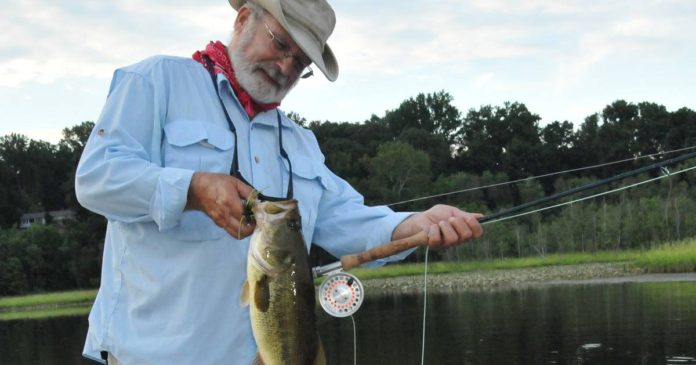Fishing for bass, pickerel, snakeheads, bowfin and even panfish species is tough in the summer, but fishing success doesn’t necessarily involve dredging the depths. Fishing shallow water can be productive if you pick the right places, times and tactics as this two-part series will explore. We’ll start with fishing lily pad and spatterdock fields and matted emergent weedbeds, hereafter referred to as “cover” or “pad fields.” Much of this information is distilled from Joe Bruce’s “How to Attack Pads.”
Stealth is a major element in fishing shallow, often clear water. Camouflage or at least natural colored clothing is recommended. If fishing from shore, tread as gently and quietly as possible. Preferred watercraft are canoes or kayaks in natural colors, without any use of electric motors or depth finders. Float tubes moved quietly with fins or paddles may suffice in some situations. Most metal boats and canoes are too noisy.
Tackle is basic and minimal. For spinning tackle use 6½ to 7-foot medium action rods, matching reels, 15 to 20-pound braid with a 20-pound bite leader where pickerel and other toothy fish are present, or a lighter leader for bass. Fly rods should be 9-foot, 7- or 8-weight, with a matching reel, floating line and a 9-foot leader with a bite tippet as above.
A variety of lures may be used outside the pads, but hollow or paddletail frogs and 1/4-ounce Johnson Silver Minnows are two of my favorites. For holes inside the pads and pad field edges, paddletail and hollow frogs, 3½ and 5-inch paddletail flukes and 6-inch curlytail worms are the choice.
Always have one rod rigged with a fluke and one with the worm. A third rod rigged with a frog is used less often but completes the “three-prong attack.” Rather than standard Texas rigging, Joe Bruce rigs flukes and worms via a hitching post on 2/0 Mustad jig hooks — models 91768BLN or 32786BLN — and opens the hook gaps slightly.
Fly fishing will only works in limited situations; weedless hair bugs are the choice.
In the early morning, preferably before the sun is on the horizon, fish will often be found within a few feet outside the edges of the cover, taking advantage of oxygen, cooler water and low light. Cast to the edges of the cover and work your frogs and plastics in gentle twitches and pauses or slowly swim weedless spoons or spinnerbaits. Work your way methodically around the edges of the entire field.
As much as possible, fish into the wind and work from the shoreline out. Often there will be narrow stretches of open water between the shore and the field. Even in very shallow water, these places can be productive especially if there are docks, anchored boats or overhanging trees. But fishing from shore or watercraft, stealth is at a premium.
Carroll County Daily Headlines
Daily
Get the day’s top news and sports headlines.
As the day continues with more light and heat, fish will retreat under cover for food, cooler temperatures and the oxygen being generated by the pads. Trying to fish a solid pad field is usually futile. However, working seams and holes in a field can pay off. Woody structure within a hole is always worth trying.
Again, to the degree possible, approach from shore and fish out into the wind. Start at the near edge of the hole and work back to the far end. I like to cast on top of the cover and work the lure a few feet before dropping it into the water and retrieving along the edge. Work from side to side of the hole and near front to back.
A plastic worm with a pulsing curly tail is arguably the best lure for this. Keep an eye out for any movement in the cover. Often you will see movement in the pads as a fish tracks the lure.
Strikes can vary from a subtle stopping of a worm or fluke to explosive. When a fish misses, cast back immediately with one of the other rigged lures. Often when a fish takes the lure it darts back into the cover. You may feel resistance on your line, but does a fish have the lure or is it just buried in the cover? Joe Bruce advises do nothing but just watch your rod tip. If a fish has the lure, you’ll see the rod tip dip slightly. Set the hook. If the rod tip doesn’t move, tighten the line. If there is a tug, set the hook; if not, retrieve for another cast.
A hooked fish will often bury into the pads or other cover. Then you have to go in after the fish. Row or paddle as close as you can then begin retrieving line by hand; a heavy line and leader can help. Shore fishermen should think twice about wading in as many of these waters have soft muddy bottoms. You may have to stay on shore, yank and hope for the best.
One of my favorite memories is a twilight magic hour fishing spatterdock edges on a moving tide with guide, Mike Starrett on the Potomac River near Mattawoman. “One foot in, one foot out,” Mike chanted as Joe Bruce and I cast weedless hair frogs into the spatterdock, walked them out, then let them drop into the water. Since we cast from open water only a foot into the cover on a tight line, only the weedless bug and the leader were in the cover; the fly line didn’t get tangled in the spatterdock. Most of the largemouths were in the 2 to 3-pound range, but action was steady until full dark.
Part 2 will describe morning and evening magic times, fishing under lights, and fishing ductwork.
Credit: Source link






























